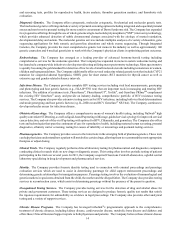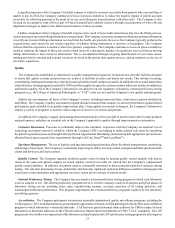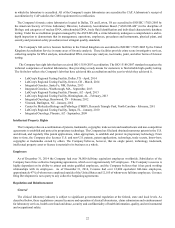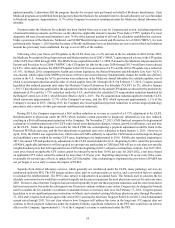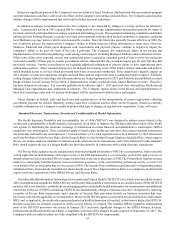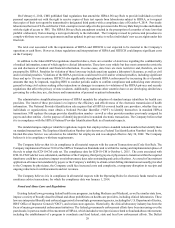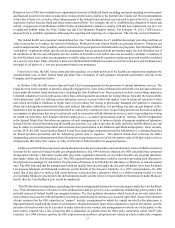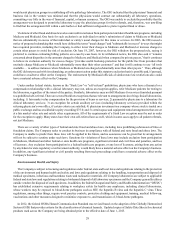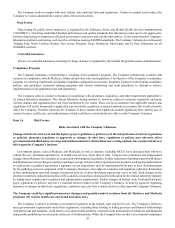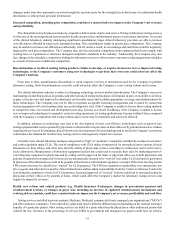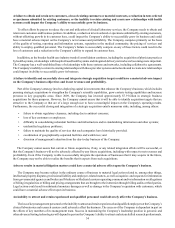LabCorp 2014 Annual Report Download - page 26
Download and view the complete annual report
Please find page 26 of the 2014 LabCorp annual report below. You can navigate through the pages in the report by either clicking on the pages listed below, or by using the keyword search tool below to find specific information within the annual report.24
updated annually. Laboratories bill the program directly for covered tests performed on behalf of Medicare beneficiaries. State
Medicaid programs are prohibited from paying more than the Medicare fee schedule limit for clinical laboratory services furnished
to Medicaid recipients. Approximately 11.7% of the Company’s revenue is reimbursed under the Medicare clinical laboratory fee
schedule.
Payment under the Medicare fee schedule has been limited from year to year by Congressional action, including imposition
of national limitation amounts and freezes on the otherwise applicable annual Consumer Price Index ("CPI") updates. For most
diagnostic lab tests, the national limitation is now 74.0% of the national median of all local fee schedules established for each test.
Under a provision of the Medicare, Medicaid, and SCHIP Benefits Improvement and Protection Act of 2000 (“BIPA”), for tests
performed after January 1, 2001 that the Secretary of Health and Human Services determines are new tests for which no limitation
amount has previously been established, the cap is set at 100% of the median.
Following a five year freeze on CPI updates to the CLFS, there was a 1.2% increase in the fee schedule in 2003. In late 2003,
the Medicare Prescription Drug, Improvement and Modernization Act of 2003 (“MMA”) again imposed a freeze in the CPI update
of the CLFS from 2004 through 2008. The MMA freeze expired December 31, 2008. Pursuant to the Medicare Improvements for
Patients and Providers Act of 2008 ("MIPPA"), the CPI update for labs for the years 2009 through 2013 would have been reduced
by 0.5%. After such reduction, the 2009 CPI update to the CLFS was an increase of 4.5% and the 2010 CPI update was a reduction
of 1.9%. In March 2010, comprehensive health care reform legislation, the Patient Protection and Affordable Care Act (“ACA”),
was enacted, which replaced the MIPPA provisions with new provisions that may fundamentally change the health care delivery
system in the U.S. Among the ACA’s provisions were reductions in the Medicare clinical laboratory fee schedule updates, one of
which is a permanent reduction and the other of which applies from 2011 through 2015. On February 17, 2012, Congress passed
legislation that reduced payment rates under the Medicare Clinical Laboratory Fee Schedule ("CLFS") by 2%, effective January
1, 2013. This reduction was applied after the adjustment of the fee schedule by the annual CPI update as reduced by the productivity
adjustment (0.9%) and the 1.75% reduction under the ACA, and before the scheduled 2% sequestration reduction mandated by
the Budget Control Act of 2011, which became effective April 1, 2013. The 2% sequestration reduction applied to both the CLFS,
which represents approximately 11.7% of the Company's revenue, and the PFS, which represents approximately 1.1% of the
Company's revenue in 2013. During 2013, the Company also faced significant payment reductions to certain surgical pathology
procedures and a variety of other government reimbursement reductions.
During 2014, the Company experienced a $6.0 million reduction in revenue as a result of a 0.75% adjustment to the CLFS.
Reimbursement to physicians under the PFS (which includes certain payments to diagnostic laboratories) was also reduced,
resulting in a $6.6 million payment reduction to the Company. On November 27, 2013, CMS finalized a proposal to begin annual
evaluations of reimbursement rates for CLFS codes based on technological changes, volume, growth in utilization, cost and time
on the CLFS. Under this proposal, test codes for which CMS was contemplating a payment adjustment would be listed in the
Proposed PFS Rule each year, and the first adjustments to payment rates were scheduled to begin January 1, 2015. However, in
April, 2014, the PAMA was signed into law, which removed CMS's authority to adjust the CLFS based on technological changes
and established a new method for setting CLFS rates, beginning to be implemented in 2016. PAMA also repealed, beginning in
2017, the annual CPI and productivity adjustments to the CLFS enacted under the ACA. Beginning in 2016, under the provisions
of PAMA, applicable laboratories will be required to report private market data to CMS that CMS will use to calculate test-specific
weighted median prices that will represent the new CLFS rates beginning in 2017, subject to certain phase-in limits. For 2017-2019,
a test price (based on applicable CPT codes) cannot be reduced by more than 10.0% per year; for 2020-2022, a test price (based
on applicable CPT codes) cannot be reduced by more than 15.0% per year. Reporting and pricing will occur every three years,
or annually for certain types of tests, to update the CLFS thereafter. Since rulemaking to implement the provisions of PAMA has
not yet begun, it is too early to assess the impact of PAMA.
Separate from clinical laboratory services, which generally are reimbursed under the CLFS, many pathology services are
reimbursed under the PFS. The PFS assigns relative value units to each procedure or service, and a conversion factor is applied
to calculate the reimbursement. The PFS is also subject to adjustment on an annual basis. The formula used to calculate the fee
schedule conversion factor would have resulted in significant decreases in payment for most physician services for each year since
2003. However, since that time Congress has intervened repeatedly to prevent these payment reductions, and the conversion factor
has been increased or frozen for the subsequent year. Decreases continue in future years unless Congress acts to change the formula
used to calculate the fee schedule or continues to mandate freezes or increases each year. On February 17, 2012, Congress passed
legislation to avert significant payment reductions in March, and extended existing Medicare physician rates through December
31, 2012 and Congress took action again at the end of 2012, passing the American Taxpayer Relief Act of 2012, which maintained
current rates through 2013. It is not clear when or how Congress will address this issue in the long term. If Congress does not
continue to block payment reductions under the statutory formula, significant reductions in the PFS rates could have an adverse
effect on the Company. Approximately 1.1% of the Company’s revenue is reimbursed under the PFS.


